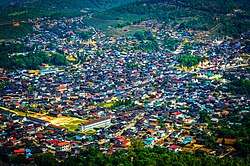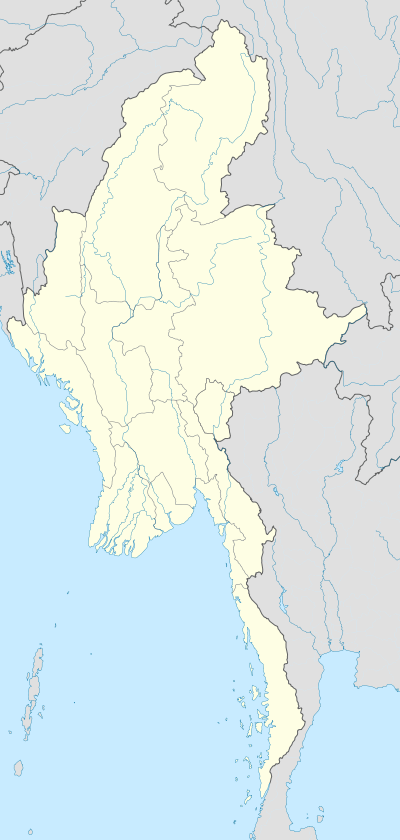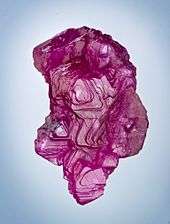Mogok
Mogok (Burmese: မိုးကုတ်မြို့; MLCTS: mui: kut mrui., [móɡoʊʔ]; Shan: မိူင်းၵုတ်ႈ, [mɤ́ŋ kut]) is a city in the Pyin Oo Lwin District of Mandalay Region of Myanmar, located 200 kilometres (120 mi) north of Mandalay and 148 kilometres (92 mi) north-east of Shwebo.
Mogok မိုးကုတ် Mogoke[1] | |
|---|---|
City | |
 | |
 Mogok Location of Mandalay, Burma | |
| Coordinates: 22°55′N 96°30′E | |
| Country | |
| Region | |
| District | Pyin Oo Lwin |
| Township | Mogok |
| Population (2005) | |
| • Total | 150,000 |
| • Religions | Theravada Buddhism |
| Time zone | UTC+6.30 (MST) |
History
Mogok is believed to have been founded in 1217 by three lost hunters who discovered rubies at the base of a collapsed mountain.[2] According to the tale, the hunters returned to their home in Momeik and offered the precios stones to the local saopha who established a village in what would become modern-day Mogok.[2]
In 2018, the Mogok commemorated the 800th anniversary of the city's founding.[3]
Geography
At 1,170 metres (3,840 ft) in elevation, the city has a fairly temperate climate year-round, and is home to Bamar, Shan, Lisu, Palaung, and Karen ethnic groups, as well as Chinese, Indians and Gurkhas. The city is composed of two towns, Mogok and Kyat Pyin. Mogok is four miles long and two miles wide. It is situated in a valley surrounded by a large number of mountains. Kyatpyin lies about 7 miles (11 km) southwest of Mogok. Tourists that travel to this area need a special authorization and a guide person.[4]
Economy
Mogok and other villages nearby have been famous since ancient times for its gemstones, especially ruby and sapphire, but semi-precious stones such as spinel, lapis lazuli, garnet, moonstone, peridot and chrysoberyl are also found. The gems are found in alluvial marble gravels by means of panning, tunneling and digging pits by hand. There is little mechanization of the mining. The gravels derive from the metamorphosed limestones (marbles) of the Mogok metamorphic belt.[5][6]
Gems are sold in markets in Mogok; however, foreigners require special permits to visit the town, and purchase/export of gems from Myanmar at non-government licensed dealers is illegal.
90% of a certain version of the world's rubies come from Myanmar (Burma). There are many other ruby sources in the world such as Sri Lanka and various places in Africa. Only in terms of quality Mogok rubies are best. The red stones from there are prized for their purity and hue. Thailand buys the majority of Myanmar's gems. The "Valley of Rubies", the mountainous Mogok area, 200 km (120 mi) north of Mandalay, is noted as the original source of ruby including the world's finest "pigeon's blood" rubies as well as the world's most beautiful sapphires in "royal" blue.
Health care
- Mogok General Hospital
- Kyatpyin General hospital
Climate
| Climate data for Mogok (1982–2010) | |||||||||||||
|---|---|---|---|---|---|---|---|---|---|---|---|---|---|
| Month | Jan | Feb | Mar | Apr | May | Jun | Jul | Aug | Sep | Oct | Nov | Dec | Year |
| Average high °C (°F) | 22.8 (73.0) |
24.8 (76.6) |
27.9 (82.2) |
29.6 (85.3) |
27.5 (81.5) |
25.4 (77.7) |
24.4 (75.9) |
25.0 (77.0) |
26.1 (79.0) |
26.2 (79.2) |
24.9 (76.8) |
22.8 (73.0) |
25.6 (78.1) |
| Average low °C (°F) | 5.0 (41.0) |
7.2 (45.0) |
10.8 (51.4) |
15.1 (59.2) |
17.9 (64.2) |
19.8 (67.6) |
19.8 (67.6) |
19.7 (67.5) |
18.9 (66.0) |
16.6 (61.9) |
11.4 (52.5) |
6.8 (44.2) |
14.1 (57.4) |
| Average rainfall mm (inches) | 6.8 (0.27) |
11.8 (0.46) |
22.0 (0.87) |
77.4 (3.05) |
362.7 (14.28) |
493.3 (19.42) |
511.3 (20.13) |
479.6 (18.88) |
337.3 (13.28) |
286.1 (11.26) |
85.8 (3.38) |
17.0 (0.67) |
2,691.1 (105.95) |
| Source: Norwegian Meteorological Institute[7] | |||||||||||||
Notes
- "Pyin Oo Lwin / Mogoke Map" Myanmar Information Management Unit (MIMU)
- "Ruby Land's 800th Anniversary showcases peaceful coexistence". The Myanmar Times. 23 March 2018. Retrieved 4 June 2020.
- "Mogok prepares to party for 800th birthday". The Myanmar Times. 23 February 2018. Retrieved 4 June 2020.
- "Archived copy". Archived from the original on 5 September 2015. Retrieved 23 February 2015.CS1 maint: archived copy as title (link)
- Searle, D. L.; Ba Than Haq (1964) "The Mogok belt of Burma and its relationship to the Himalayan orogeny" Proceedings of the 22nd International Geological Conference, Delhi 11: pp. 132–161
- Iyer, Lakshinarayanpuran Anantkrishna Narayana (1953) The geology and gem-stones of the Mogok Stone Tract, Burma Geological Survey of India Memoir 82, Government of India Press, Calcutta, OCLC 6526679 ; reprinted in 2007 by White Lotus, Bangkok, ISBN 978-974-480-123-4
- "Myanmar Climate Report" (PDF). Norwegian Meteorological Institute. pp. 23–36. Archived from the original (PDF) on 8 October 2018. Retrieved 1 December 2018.
| Wikimedia Commons has media related to Mogok. |


